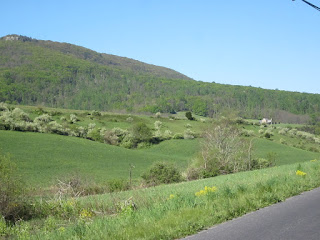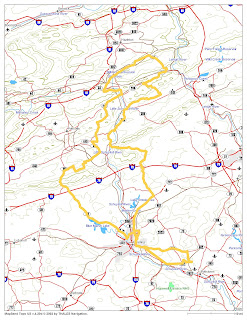8 hours 14 minutes elapsed time
4 hours 2 minutes riding time
176 miles
43.7 mph ave
Beemer stats:
183 miles
42 mph ave
46 mpg


 The morning started with a light frost on the grass and windshields of the cars. The temperature was 35 as I was dressing to head out, so I included the long LD base layer, extra Aerostitch jersey windbreak and, of course, electric jacket, plus chin fleece and medium gloves - with the electric hand grips, plenty warm riding over to form-up at 8:00. By the time we headed towards breakfast, the sun was out and temps were up a comfortable (with heat) 40+. We wandered up through Pine Creek valley and over Hawk Mountain. An hour and 20 minutes of riding got us to Nequehoning fire house with a good cup of coffee and made-to-order breakfast for $7 - can't beat it with a stick.
The morning started with a light frost on the grass and windshields of the cars. The temperature was 35 as I was dressing to head out, so I included the long LD base layer, extra Aerostitch jersey windbreak and, of course, electric jacket, plus chin fleece and medium gloves - with the electric hand grips, plenty warm riding over to form-up at 8:00. By the time we headed towards breakfast, the sun was out and temps were up a comfortable (with heat) 40+. We wandered up through Pine Creek valley and over Hawk Mountain. An hour and 20 minutes of riding got us to Nequehoning fire house with a good cup of coffee and made-to-order breakfast for $7 - can't beat it with a stick.2 hours+ of lies, tall tales, future plans, and firehouse coffee finally got us back on the road. We took a loop to the north and west through the valley-and-ridge with temps climbing up into the mid-60's, pretty perfect riding conditions. The trees are coming into spring leaf, a week or two behind us north of the mountain. Lilacs are past prime, and azaleas are at their peak, especially farther north.
It might have been an uneventful day, but then the "adventure" set in. It started when Dave passed a slow car on his F650 GS, using all the ponies. Afterward, acceleration seemed slow and uneven; something was definitely amiss. Then Tim started having trouble with corner lines, leading us to pull over in a parking lot at the junction of Rts 895 and 183.
Tim had picked up a piece of metal in his rear tire, which was nearly flat. Dave's chain had some very stiff links and the teeth on his rear sprocket were all distorted from the pull of the chain, looking more like shark's teeth than a drive sprocket. Meanwhile, my bike started acting up, refusing to start intermittently - either nothing at all when the button was pressed or starter kicking in then quitting immediately before the engine caught.

Dave's tire plug kit was handily stored in the side bag of his Triumph, sitting home in the garage. Luckily, following my run-in with the fencing staple last summer, I had bought a tire plug kit and portable, battery driven compressor. And they were handily stored in the side bag of my one and only, so out they came. It took two tries with the new-fangled plug system, but we got one in and were slooowly pumping up the tire with the portable compressor when a local resident came over to see if we needed any help. Turns out he worked in the auto body shop whose parking lot we had landed in and was glad to turn on the compressor for us. With the full scale compressor, the tire was soon up to 40 psi. It appeared to have a slow leak - might not have seated the new-style plug firmly enough - but good enough to get home. So with Dave's chain loose and rattling - not much else to be done at that point - and Tim watching the tire pressure, once I managed to get my bike started, we limped on home.
At Tim's house, we loaded up his two new tires on the back of Dave's and my bikes to take them down to Dave's house so they can be changed when Tim rides over some evening this week.
Dave will have to ride one of his Triumphs until he gets a new sprocket set and chain installed on the F650.
After perusal of various threads on the internet, I determined that my starting problems stem from the computer controlled interlock system. Seems the gear sensor on the transmission is slightly out of calibration; with the bike in neutral, and "N" indicated on the display, whenever the starter motor starts drawing current the sensor sends a "2" signal (the sensor is a variable resistor that moves as the gears are changed, may be affected by the voltage drop due to started motor load) which flashes briefly on the display. If the kickstand is down or the clutch lever out, the computer immediately kills the starter because it thinks the bike is in gear. This is the cause of the starter-kicks-in-then-quits syndrome. The only way to start the bike is to put the kickstand up and pull in the clutch so it is allowed to start in gear. HOWEVER, the computer needs to confirm that the clutch and side stand switches are working, so if you put the stand up or pull the clutch in before turning on the ignition, it refuses to acknowledge the switch and prevents to bike from starting, the nothing-happens-when-you-press-the-button syndrome. Now that I know the correct sequence, I can start the bike reliably, even with this problem.
Following advice from the net, I disconnected the transmission sensor, and examined the plug for corrosion (it looked OK), cycled the ignition on and off with the sensor disconnected, then reconnected, after spraying the plug with WD-40. I started the bike and took it out to run it through the gears. This appears to have solved the problem. Apparently, the computer can tell which gear the bike is in from engine RPM and road speed. Turning on the ignition with the sensor disconnected tells the computer that it needs to recalibrate the sensor, so the next time it finds the sensor connected, it determines which resistance values from the sensor correspond to which gears based on the engine and road speeds. Well, anyway, that's my story and I'm sticking to it.





By the way, the new Canon A1200 camera works great in this application. It has a DC-in jack, so I bought a generic plug and cord from Radio Shack and wired it in to the 3.5 V power on the bike (derived from the 12 V to 3.5 V that came with the GPS, but I could wire up my own and could give you a circuit diagram if you need one). So now it has a set of battery for unplugging and taking it off of the bike but is plugged in when it's on the RAM mount on the handlebars. I set it for blur-reduction and can easily punch the buttons to turn it on/off or take a pic with gloves on. On a brightly lit day , it takes a pretty clear photo most of the time despite being jiggled around on a motorcycle. The view is whatever is out in front with a wide angle lens.
ReplyDelete